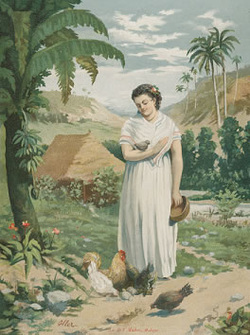 "La Guajira", 1876, from the book, "Las Mujeres Portuguesas, Españolas, y Americanas".
"La Guajira", 1876, from the book, "Las Mujeres Portuguesas, Españolas, y Americanas".
The Guajira is one of the palos de ida y vuelta, or "round-trip rhythms" of Flamenco. These rhythms originated when Spaniards encountered the rhythms of Latin America, brought them back to Spain, and combined them with their own.
The Guajira specifically is named after a Cuban musical form of the same name. A "guajira" or "guajiro" is a person from the countryside, so the songs that fit this description tend to be about images and people of the countryside of Cuba. I guess you can say that Guajira is Cuban country music or at least, a style of Cuban country music. Also, this music is typically identified by the fact that it features the guitar and similar stringed instruments, as opposed to the drums and horns found in other types of Cuban music.
Before I continue, I want to preface what I present here by saying that I am not an ethnomusicologist, so please understand that I am simply sharing what I have found by doing my own research, a la internet. If there are any Cuban or Spanish music history buffs out there who have better details about how either style of Guajira came to be, please feel free to share in the comments below. I am just a Cuban-American Flamenco bailaora looking to make her Guajira study more interesting.
Anyway, according to what I have found through my arduous Googling, the music form most Cubans identify as Guajira, is not exactly like the original Guajira that came about around 1900, and is attributed to composer, Jorge Anckermann. According to the Wickipedia site for Guajira, Anckermann originally wrote this music for the theater.
After some more fishing around the "interwebs", I found the following You Tube video of a guitarist playing, "El Arroyo Que Murmura", or "The Murmuring Creek", an original Guajira composed by Anckermann:
For those of you who aren't familiar with either of these forms or with music language itself, it's easier for me to just show you, so here, I found another recording, this one dated 1914, of Manuel Escacena singing Flamenco Guajiras:
You may think that this recording by Guillermo Portabales sounds familiar. That's because you probably heard Buena Vista Social Club perform his song, "El Carretero" or, "The Wagoneer":
Me gusta por la mañana,
despues del café bebío,
pasearme por la Habana,
con mi cigarro encendío,
y sentarme muy tranquilo,
en mi silla o mi sillón,
y comprarme un papelón,
de esos que llaman díario,
y parezco un millonario,
rico de la población.
I like, In the mornings,
after drinking my coffee,
to stroll around Havana,
with my cigar lit,
and then sit peacefully,
in my chair or my armchair,
and buy myself one of those big newspapers,
they call dailies,
and look like one of those
rich millionaires of society.
Did you like this entry or find it helpful in understanding more about Flamenco or Guajira? If so, please Like it and Share it with your friends.
Do you know anything else about this history of Guajira? Or, have you danced or played Guajira before? What do you think of the Guajira? I would love to hear your thoughts in the comments below. Also, like I said before, I'm a professional Bailaora, but an amateur sleuth, so if you are a music historian and know some more details about Guajira, feel free to add them in the comments below as well!
 RSS Feed
RSS Feed
